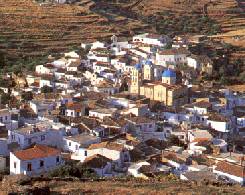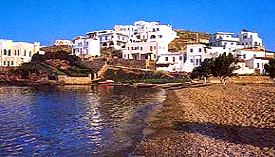|
|
Kithnos Island
 History:
Kithnos is the second island from the north of the west
Cyclades, between Kea and Seriphos. History:
Kithnos is the second island from the north of the west
Cyclades, between Kea and Seriphos.
One of the
initially inhabited islands of the Cyclades, in the Mesolithic
years 7500-6500 BC. At first it was named Draopis from the
name of its first inhabitants, the Dryopes, an ancient
prehellenic people. Later it was named Kithnos from the name
of the island's king Kithnos.
It has been
also reported as Thermia because of the numerous thermal
springs that run through the island. It flourished to a great
degree, during the antiquity. It offered two ships by fighting
with the Athenian alliance against the Persians and the name
of the Kithnians was written onic the tripod of Delphi. It was
successively colonized by the Macedonians, the Ptolemies and
the Romans. It also belonged to the Duchy of Naxos when it was
conquered by the Francs.
 It was one of the first islands to
revolt and join Greece in 1832. During the ruler ship of Othon
it was used as a place of exile for the leaders of the
revolutionary movement of Nauplio. Chora or Messaria is built
in the interior part of the island, and is 8 km away from the
port of Mericha. To the southeast of the island there is the
village and the homonymous church of Panagia tis Kenalas
(Virgin Mary of Canala), protector of the island, the pictures
of whom are the fine artwork of the famous renowned Cretan
painter Antonis Scordilis. It was one of the first islands to
revolt and join Greece in 1832. During the ruler ship of Othon
it was used as a place of exile for the leaders of the
revolutionary movement of Nauplio. Chora or Messaria is built
in the interior part of the island, and is 8 km away from the
port of Mericha. To the southeast of the island there is the
village and the homonymous church of Panagia tis Kenalas
(Virgin Mary of Canala), protector of the island, the pictures
of whom are the fine artwork of the famous renowned Cretan
painter Antonis Scordilis.
Beaches
for swimming:
Loutra, Schinari, Sarantou, Kavourokeri, Potamia, Agios
Sostis, Maroula, Mamakou.
|
>> Cyclades Islands : Amorgos, Anafi,
Andros, Antiparos,
Delos, Folegandros,
Ios, Kea,
Kimolos, Kithnos,
Koufonisia, Milos,
Mykonos, Naxos,
Paros, Santorini,
Serifos, Sifnos,
Sikinos, Syros,
Tinos.
|
|